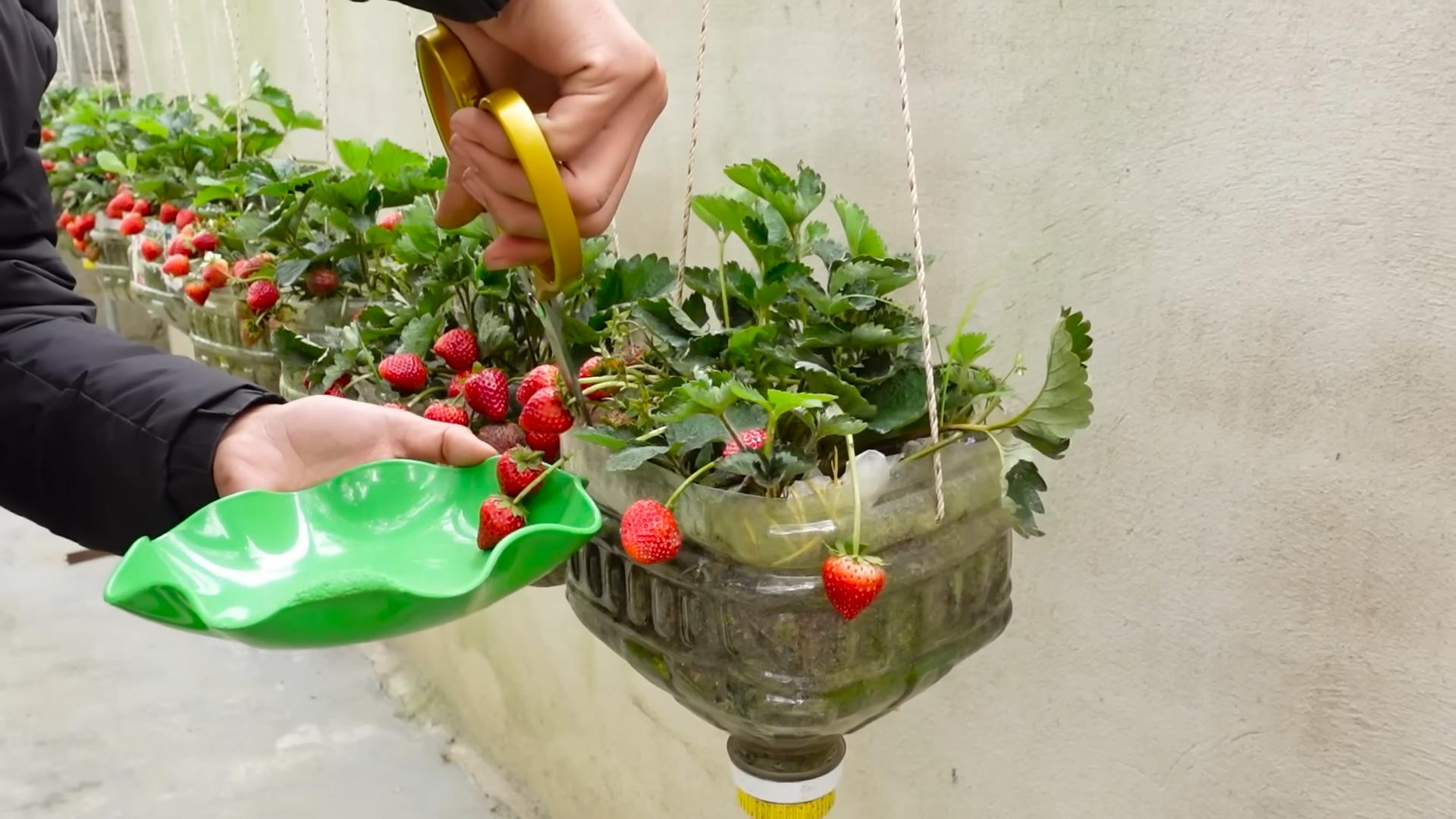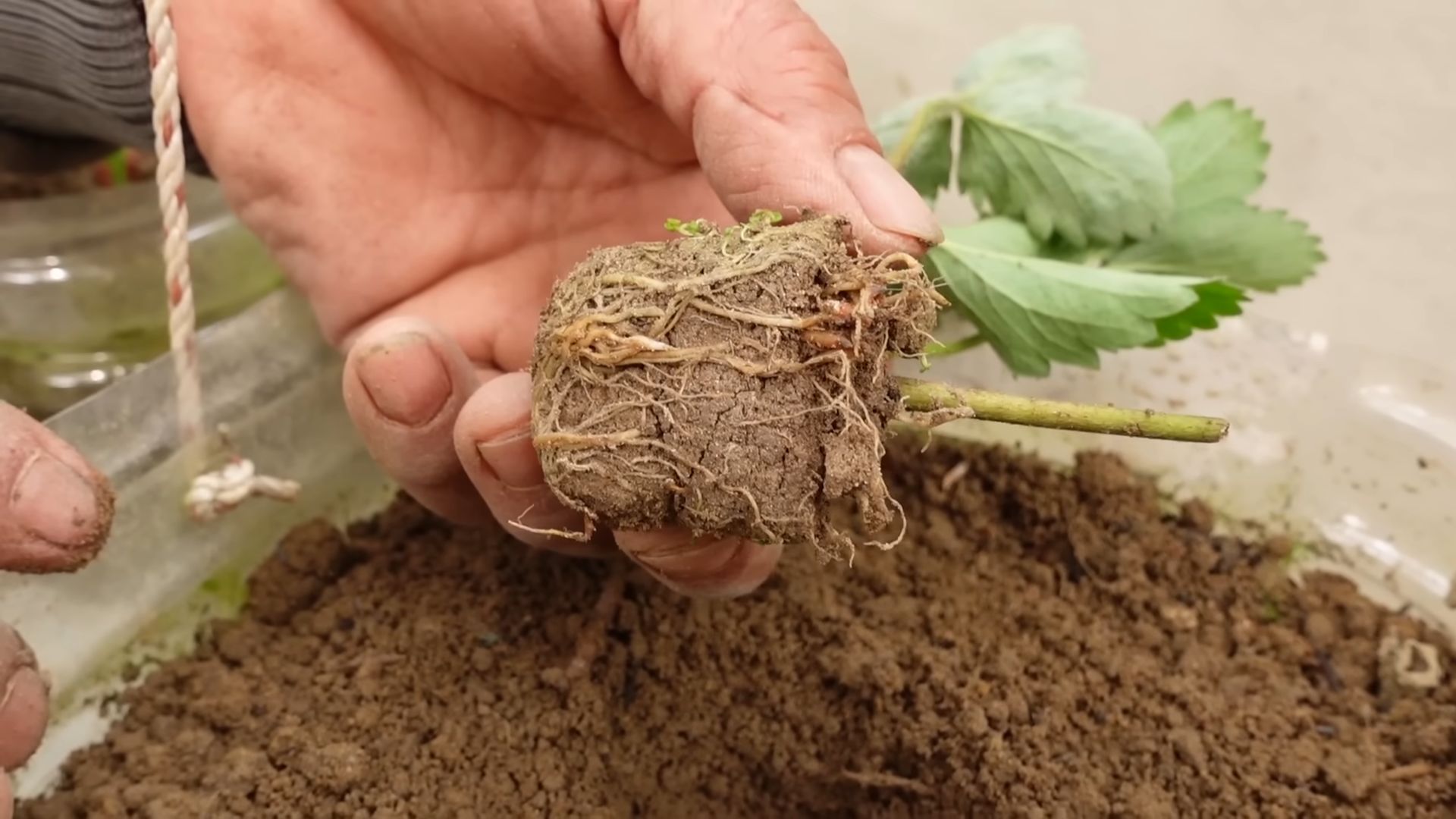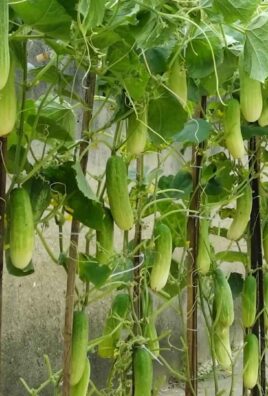Growing Strawberries at Home is easier than you think, and I’m here to show you how! Imagine plucking juicy, sun-ripened strawberries straight from your own backyard – a taste of summer that’s fresher and more flavorful than anything you can buy in the store. For centuries, strawberries have been cherished not only for their delicious taste but also for their vibrant color and symbolism of love and abundance. From ancient Roman gardens to medieval monastery plots, these little red gems have captivated hearts and palates across cultures.
But let’s be honest, the thought of cultivating your own strawberry patch can seem daunting. Maybe you’ve tried before with little success, or perhaps you’re simply intimidated by the idea of gardening. That’s where these simple DIY tricks and hacks come in! I’m going to share some easy-to-follow methods that will transform even the most novice gardener into a strawberry-growing pro.
Why do you need these DIY tricks? Because store-bought strawberries often lack the intense flavor and sweetness of homegrown varieties. Plus, you’ll know exactly what’s going into your berries – no harmful pesticides or chemicals! Growing Strawberries at Home allows you to enjoy a healthier, more sustainable, and incredibly rewarding gardening experience. So, grab your gardening gloves, and let’s get started on this berry-licious adventure!

Growing Strawberries at Home: A Beginner’s Guide
Hey there, fellow gardening enthusiasts! I’m so excited to share my experience and tips on growing delicious, juicy strawberries right in your own backyard (or even on your balcony!). Nothing beats the taste of a freshly picked strawberry, and trust me, it’s easier than you think to cultivate your own little strawberry patch. Let’s dive in!
Choosing the Right Strawberry Variety
Before we get our hands dirty, it’s important to pick the right strawberry variety for your climate and preferences. There are three main types:
* June-Bearing: These produce one large crop of strawberries, usually in late spring or early summer. They’re great if you want a big harvest for making jam or freezing.
* Everbearing: As the name suggests, these produce strawberries throughout the growing season, with peaks in spring and fall. They’re perfect for continuous snacking!
* Day-Neutral: Similar to everbearing, day-neutral varieties produce fruit throughout the growing season, regardless of day length. They’re a good choice for areas with hot summers.
Consider your local climate and how much time you want to dedicate to harvesting when choosing. I personally love everbearing varieties because I enjoy having fresh strawberries available for a longer period.
Preparing Your Strawberry Bed
Strawberries need a sunny spot and well-drained soil to thrive. Here’s how to prepare the perfect bed:
* Sunlight: Strawberries need at least 6-8 hours of direct sunlight per day. Choose a location that gets plenty of sunshine.
* Soil: Strawberries prefer slightly acidic soil with a pH between 5.5 and 6.5. Amend your soil with compost or peat moss to improve drainage and fertility.
* Weed Removal: Thoroughly remove all weeds from the planting area. Weeds compete with strawberries for nutrients and water.
* Soil Testing: If you’re unsure about your soil’s pH, consider getting a soil test kit from your local garden center. This will help you determine if you need to add any amendments.
Planting Your Strawberry Plants
Now for the fun part – planting! Here’s a step-by-step guide:
1. Soak the Roots: Before planting, soak the roots of your strawberry plants in water for about an hour. This will help them rehydrate and get off to a good start.
2. Dig the Holes: Dig holes that are large enough to accommodate the roots of your plants. Space the holes about 12-18 inches apart for June-bearing varieties and 8-12 inches apart for everbearing and day-neutral varieties.
3. Planting Depth: The most important thing is to plant the crown (the point where the roots meet the stem) at soil level. Planting too deep can cause the crown to rot, while planting too shallow can dry out the roots.
4. Spread the Roots: Gently spread the roots out in the hole before covering them with soil.
5. Water Thoroughly: After planting, water the plants thoroughly to help settle the soil and encourage root growth.
6. Mulch: Apply a layer of mulch around the plants to help retain moisture, suppress weeds, and keep the berries clean. Straw is a popular choice for mulching strawberries (hence the name!), but you can also use wood chips or pine needles.
Caring for Your Strawberry Plants
Once your strawberry plants are in the ground, it’s important to provide them with proper care to ensure a bountiful harvest.
* Watering: Strawberries need consistent moisture, especially during fruit production. Water deeply whenever the top inch of soil feels dry. Avoid overhead watering, as this can promote fungal diseases. Drip irrigation is a great option for watering strawberries.
* Fertilizing: Fertilize your strawberry plants in early spring and again after the first harvest. Use a balanced fertilizer that is specifically formulated for berries. Follow the instructions on the fertilizer package carefully.
* Weed Control: Regularly remove any weeds that pop up around your strawberry plants. Weeds compete with strawberries for nutrients and water.
* Pest and Disease Control: Keep an eye out for common strawberry pests and diseases, such as slugs, snails, aphids, and fungal diseases. Use organic pest control methods whenever possible.
* Removing Runners: June-bearing strawberries produce runners (long stems that grow horizontally and develop new plantlets). To encourage fruit production, remove these runners regularly. Everbearing and day-neutral varieties produce fewer runners, so you don’t need to remove them as often.
* Protecting from Birds: Birds love strawberries just as much as we do! To protect your berries, cover your plants with netting or use bird repellent devices.
Harvesting Your Strawberries
The moment you’ve been waiting for! Here’s how to harvest your strawberries:
1. Ripeness: Strawberries are ready to harvest when they are fully red and slightly soft to the touch.
2. Gentle Picking: Gently grasp the stem of the strawberry and twist it off the plant. Avoid pulling on the berry, as this can damage the plant.
3. Harvest Regularly: Harvest your strawberries every few days to prevent them from becoming overripe and attracting pests.
4. Handle with Care: Strawberries are delicate, so handle them with care to avoid bruising.
Growing Strawberries in Containers
Don’t have a garden? No problem! You can easily grow strawberries in containers.
* Container Size: Choose a container that is at least 12 inches in diameter and 8 inches deep.
* Potting Mix: Use a high-quality potting mix that is well-draining.
* Planting: Plant your strawberry plants in the container, following the same planting instructions as for in-ground planting.
* Location: Place the container in a sunny location that gets at least 6-8 hours of direct sunlight per day.
* Watering: Water the container regularly, as containers tend to dry out more quickly than in-ground gardens.
* Fertilizing: Fertilize your strawberry plants in the container regularly, following the instructions on the fertilizer package.
* Overwintering: In colder climates, you may need to protect your container-grown strawberries from freezing temperatures. You can move the container to a sheltered location, such as a garage or shed, or wrap the container with burlap.
Extending the Strawberry Season
Want to enjoy fresh strawberries for even longer? Here are a few tips:
* Succession Planting: Plant different varieties of strawberries that ripen at different times. This will extend your harvest season.
* Row Covers: Use row covers to protect your strawberry plants from frost in the spring and fall. This can help you get an earlier start to the season and extend it later into the fall.
* Cold Frames: Build a cold frame over your strawberry plants to provide extra protection from the cold. This can help you overwinter your plants and get an even earlier start to the season.
Troubleshooting Common Strawberry Problems
Even with the best care, you may encounter some problems when growing strawberries. Here are a few common issues and how to address them:
* Lack of Fruit: If your strawberry plants are not producing fruit, it could be due to a lack of sunlight, poor soil, or improper watering. Make sure your plants are getting enough sunlight, amend your soil with compost, and water regularly.
* Small Berries: Small berries can be caused by a lack of nutrients or water. Fertilize your plants regularly and water deeply whenever the top inch of soil feels dry.
* Rotting Berries: Rotting berries can be caused by fungal diseases. Avoid overhead watering and ensure good air circulation around your plants. Remove any infected berries immediately.
* Pest Infestations: Keep an eye out for common strawberry pests, such as slugs, snails, and aphids. Use organic pest control methods to control these pests.
Propagating Strawberries
Once you have a thriving strawberry patch, you can easily propagate new plants from runners.
1. Select Runners: Choose healthy runners that have developed roots.
2. Cut the Runner: Cut the runner from the mother plant, leaving a few inches of stem attached to the new plantlet.
3. Plant the Plantlet: Plant the plantlet in a pot filled with potting mix.
4. Water Regularly: Water the plantlet regularly until it is well-established.
5. Transplant: Once the plantlet has developed a strong root system, you can transplant it to your garden.
Enjoying Your Harvest
Now that you’ve harvested your delicious strawberries, it’s time to enjoy them! Here are a few ideas:
* Eat them fresh: Nothing beats the taste of a freshly picked strawberry!
* Make jam: Strawberry jam is a classic and delicious way to preserve your harvest.
* Bake a pie: Strawberry pie

Conclusion
So, there you have it! Growing strawberries at home, while it might seem daunting at first, is an incredibly rewarding experience that brings the sweet taste of summer right to your backyard. We’ve explored the key steps, from selecting the perfect variety to nurturing your plants for a bountiful harvest. But why is this DIY trick a must-try?
Firstly, the flavor. Store-bought strawberries, while convenient, often lack the intense sweetness and aroma of homegrown berries. When you grow your own, you control the ripening process, picking them at their peak of flavor. This means you’re enjoying strawberries bursting with sunshine and natural sugars, a taste sensation you simply can’t replicate with commercially grown fruit.
Secondly, it’s incredibly satisfying. There’s something deeply fulfilling about nurturing a plant from a tiny seedling to a fruit-bearing marvel. Watching your strawberry plants thrive, knowing you’ve provided the care and attention they need, is a truly rewarding experience. Plus, it’s a fantastic way to connect with nature and appreciate the simple pleasures of gardening.
Thirdly, it’s healthier. You know exactly what’s going into your strawberries – no harsh pesticides or artificial fertilizers, unless you choose to use them. You can opt for organic methods, ensuring your berries are as pure and natural as possible. This is especially important if you have children or are concerned about the chemicals in your food.
But the benefits don’t stop there. Growing strawberries at home is also a great way to save money, especially if you’re a strawberry lover. Over time, your initial investment in plants and supplies will pay off as you harvest a steady supply of delicious berries.
Looking for variations? Consider growing different varieties of strawberries to extend your harvest season and enjoy a range of flavors. Everbearing varieties produce fruit throughout the summer, while June-bearing varieties offer a large crop in early summer. You can also experiment with different growing methods, such as raised beds, hanging baskets, or even vertical planters, to maximize your space and create a visually appealing garden. Another fun variation is to try growing alpine strawberries, which are smaller and more intensely flavored than traditional varieties. They also tend to be more shade-tolerant.
Don’t be afraid to experiment with companion planting. Basil, thyme, and borage are all excellent companions for strawberries, helping to deter pests and improve flavor. Marigolds are also a great choice for repelling nematodes.
Growing strawberries at home is more than just a gardening project; it’s an investment in your health, your taste buds, and your connection with nature. So, grab your gardening gloves, choose your favorite strawberry variety, and get ready to embark on a delicious adventure. We encourage you to try this DIY trick and experience the joy of harvesting your own sweet, juicy strawberries.
And most importantly, don’t forget to share your experience! We’d love to hear about your successes, your challenges, and any tips you’ve learned along the way. Share your photos and stories on social media using #HomegrownStrawberries or leave a comment below. Let’s build a community of strawberry enthusiasts and inspire others to discover the joys of growing their own food. Happy gardening!
Frequently Asked Questions (FAQ)
What is the best time of year to plant strawberries?
The best time to plant strawberries depends on your climate and the type of strawberry you’re planting. In general, early spring or late fall are ideal times. For June-bearing varieties, planting in early spring allows them to establish themselves before the heat of summer. For everbearing and day-neutral varieties, planting in late fall allows them to develop strong root systems before winter, leading to a better harvest the following year. If you live in a region with mild winters, you can plant strawberries throughout the winter months. However, avoid planting during periods of extreme heat or cold. Consider your local climate and consult with your local nursery for the best planting time for your specific area.
How much sunlight do strawberries need?
Strawberries thrive in full sun, requiring at least 6-8 hours of direct sunlight per day. Sunlight is crucial for photosynthesis, which is the process by which plants convert light energy into chemical energy for growth and fruit production. Insufficient sunlight can lead to smaller, less flavorful berries and reduced yields. If you live in a particularly hot climate, providing some afternoon shade can help prevent the plants from overheating. However, ensure they still receive ample sunlight throughout the day. When choosing a location for your strawberry plants, observe the sunlight patterns throughout the day to ensure they receive adequate exposure.
What kind of soil is best for growing strawberries?
Strawberries prefer well-drained, slightly acidic soil with a pH between 5.5 and 6.5. The soil should be rich in organic matter to provide essential nutrients and improve drainage. Before planting, amend the soil with compost, aged manure, or other organic materials to improve its fertility and structure. Avoid heavy clay soils, as they can retain too much water and lead to root rot. If you have clay soil, consider growing your strawberries in raised beds or containers with a well-draining potting mix. You can also test your soil’s pH using a soil testing kit and adjust it accordingly with lime (to raise the pH) or sulfur (to lower the pH).
How often should I water my strawberry plants?
Water your strawberry plants regularly, especially during dry periods. The frequency of watering will depend on the weather, soil type, and the age of the plants. Newly planted strawberries need more frequent watering to establish their root systems. Established plants should be watered deeply whenever the top inch of soil feels dry to the touch. Avoid overwatering, as this can lead to root rot. Water at the base of the plants to avoid wetting the foliage, which can increase the risk of fungal diseases. Using a soaker hose or drip irrigation system can help deliver water directly to the roots and minimize water waste. Mulching around the plants can also help retain moisture in the soil.
How do I protect my strawberries from pests and diseases?
Protecting your strawberries from pests and diseases is essential for a successful harvest. Common pests that affect strawberries include slugs, snails, aphids, and spider mites. You can control these pests by handpicking them, using organic pesticides such as neem oil or insecticidal soap, or introducing beneficial insects such as ladybugs. To protect against slugs and snails, use beer traps or copper tape around your plants. Common diseases that affect strawberries include gray mold, leaf spot, and powdery mildew. Prevent these diseases by providing good air circulation, avoiding overhead watering, and removing any infected leaves. You can also use organic fungicides such as copper fungicide or sulfur to control fungal diseases. Regularly inspect your plants for signs of pests or diseases and take action promptly to prevent them from spreading.
When will my strawberry plants start producing fruit?
The time it takes for your strawberry plants to start producing fruit depends on the variety and the planting time. June-bearing varieties typically produce fruit the following year after planting, while everbearing and day-neutral varieties may produce a small crop in the first year. To encourage fruit production, ensure your plants receive adequate sunlight, water, and nutrients. Remove any flowers that appear in the first few weeks after planting to allow the plants to focus on developing strong root systems. Once the plants are established, allow the flowers to develop into fruit. Harvest the berries when they are fully ripe and red, but still firm.
How do I overwinter my strawberry plants?
Overwintering strawberry plants is essential for protecting them from cold temperatures and ensuring a good harvest the following year. In colder climates, mulch around the plants with straw or pine needles to insulate the roots. You can also cover the plants with a row cover or a cold frame for added protection. In milder climates, mulching may be sufficient. Avoid pruning the plants in the fall, as the foliage provides insulation. Water the plants thoroughly before winter to ensure they are well-hydrated. In the spring, remove the mulch gradually as the weather warms up.





Leave a Comment